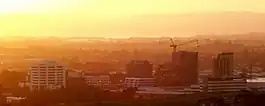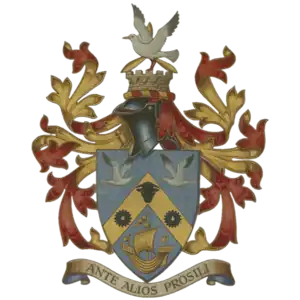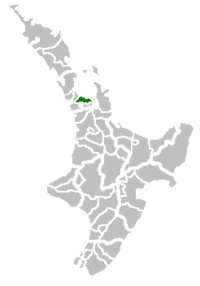Manukau City | |
|---|---|
Territorial authority of New Zealand | |
 The Manukau skyline looking northwest. | |
 Coat of arms | |
| Nickname: South Auckland | |
| Motto: Ante Alios Prosili (Be ahead of the times) | |
 Manukau City within New Zealand | |
 Manukau City (in orange) within the Auckland metropolitan area. The darker orange indicates the urban area. | |
| Coordinates: 36°59′S 174°53′E / 36.983°S 174.883°E | |
| Country | New Zealand |
| Island | North Island |
| Region | Auckland |
| Wards | Botany-Clevedon, Howick, Māngere, Manurewa, Otara, Pakuranga, Papatoetoe |
| Government | |
| • Mayor | Barry Curtis (1983-2007) Len Brown (2007–2010) |
| Area | |
| • Total | 683 km2 (264 sq mi) |
| Time zone | UTC+12 (NZST) |
| • Summer (DST) | UTC+13 (NZDT) |
| Area code | 09 |
| Website | manukau.govt.nz |
Manukau City was a territorial authority district in Auckland, New Zealand, that was governed by the Manukau City Council. The area is also referred to as "South Auckland", although this term never possessed official recognition and does not encompass areas such as East Auckland, which was within the city boundary. It was a relatively young city, both in terms of legal status and large-scale settlement – though in June 2010, it was the third largest in New Zealand, and the fastest growing.[1] In the same year, the entire Auckland Region was amalgamated under a single city authority, Auckland Council.
The name Manukau, originating from the Manukau Harbour west of the city, is of Māori origin, and means "wading birds",[2] although it has been suggested that the original name of the harbour was Mānuka, meaning a marker post with which an early chief is said to have claimed the area.[3]
History
Manukau City was formed by the amalgamation of Manukau County and Manurewa Borough in 1965. The council originally housed their offices at the Nathan Estate (now the Auckland Botanic Gardens, until permanent offices were constructed.[4] The city expanded in a 1989 New Zealand-wide re-organisation of local government, absorbing Papatoetoe City and Howick Borough, but losing some land to the newly formed Papakura District. On 1 November 2010, Manukau City Council was abolished, and the governed area was amalgamated into the Manukau, Howick, Manurewa-Papakura, and Franklin wards of the new Auckland "super city".
The district was named in 1965 by a poll of residents, ahead of other suggestions that included Churchill (after Sir Winston Churchill); Hobson and Fergusson (after governors general); Massey and Savage (after prime ministers); Kennedy, Rutherford, Ngarimu, Herewini, Snell, Mananui and Manukaurewa.
Manukau County
In 1923, Manukau County covered 195 sq mi (510 km2) and had a population of 6,146, with 163 mi (262 km) of gravel roads, 90 mi (140 km) of mud roads and 115 mi (185 km) of tracks.[5]
Geography
The Manukau City area is concentrated immediately to the south of the Ōtāhuhu isthmus, the narrowest connection between Auckland City and the Northland region and the rest of the North Island. At its narrowest, between the Otahuhu Creek arm of the Tamaki River (itself an estuarial arm of the Hauraki Gulf) in the east and the Māngere Inlet (an arm of the Manukau Harbour) to the west, the isthmus is only some 1500 metres across.
The area to the south of the isthmus contains the heart of Manukau, sprawled on either side of state highways 1 and 20, the latter of which approaches from the west after crossing Māngere Bridge. The area known as Manukau Central is located close to the junction of these two highways, some 20 kilometres southeast of the centre of Auckland city.
Considerable rural and semi-rural land to the east of Manukau Central was within the city council district. This extended towards the Hunua Ranges close to the Firth of Thames, and took in such communities as Clevedon and Maraetai.
Beyond Manukau City to the south is Papakura and the Franklin District, which are less urban, but still part of the Auckland Region, and to some extent regarded as an integral part of Auckland's urban area.
Auckland Airport is located in Māngere, in the west of Manukau, close to the waters of the Manukau Harbour. Manukau City includes the theme park Rainbow's End, and one of the oldest shopping malls in the country, now called Westfield Manukau City.
Transport
In 2009, work started on the Manukau Branch passenger railway line from the North Island Main Trunk at Puhinui.[6] The branch line opened on 15 April 2012[7] with Manukau railway station as the terminus for Eastern Line services. The Manukau Institute of Technology university campus building is built over the top of the station, which serves the Manukau city centre. On 7 April 2018, a 23-bay bus station (Manukau bus station) was opened on a lot adjacent to the train station to create a transport hub serving most of the southern Auckland Region.[8]
Population
For some years before the 1989 re-organisation of local government, Manukau City had the highest population of any city or district in the country.
Like most of the rest of the region, Manukau is ethnically diverse, and is home to many people, especially Māori and members of Polynesian ethnicities, with a recent concentration of Asians in and near Howick. It is densely populated by New Zealand standards, despite having very few apartments or other forms of attached housing.
As of the late 2000s, slightly less than 50% of the city's population identified as European, with 17% as Māori, 27% as Pacific, and 15% as Asian, with the balance made up of other groups.[1]
Schools
Administrative divisions
Prior to being merged into Auckland Council in 2010, Manukau City was divided into seven wards; each of them consisting of the following populated places (i.e.: suburbs, towns, localities, settlements, communities, hamlets, etc.):
|
|
|
|
- Notes
- ↑ Otherwise known as Manukau Central or Manukau CBD.
Prominent people
- Len Brown, former Mayor, and former Mayor of Auckland
- Jim Anderton, former city councillor, who rose to be the country's Deputy Prime Minister
- Sir Barry Curtis, former long-serving Mayor, from 1983 to 2007
- David Lange, former Prime Minister of New Zealand and Member of Parliament for Māngere
- Award-winning rapper and former member of The Deceptikonz, Savage
Local government
The Manukau City Council was the elected local authority of the city from 1965 until November 2010 when the Auckland Council was created.
Manukau City had an elected Youth Council which primarily acted as an advisory committee and advocate for youth in the city.
Coat of arms
 |
|
Sister cities
 Utsunomiya, Tochigi, Japan
Utsunomiya, Tochigi, Japan
References
- 1 2 About Manukau (from the Manukau City Council website. Accessed 21 June 2008.) Archived 25 April 2008 at the Wayback Machine
- ↑ "Naming the Manukau (Manuka) Harbour". www.aucklandlibraries.govt.nz. Archived from the original on 12 July 2016. Retrieved 6 January 2016.
- ↑ Manukau – Naming the harbour (from Te Ara: The Encyclopedia of New Zealand. Accessed 22 June 2008.)
- ↑ Wichman, Gwen (2001). Soaring Bird: a History of Manurewa to 1965. Manurewa: Manurewa Historical Society. p. 94. ISBN 0-473-07114-2. Wikidata Q117421984.
- ↑ "KAWHIA SETTLER AND RAGLAN ADVERTISER Main Highways - Conference at Hamilton". paperspast.natlib.govt.nz. 3 August 1923. Retrieved 16 October 2021.
- ↑ Dearnaley, Mathew (18 September 2009). "Work starts on $90m rail link". The New Zealand Herald. Retrieved 19 October 2011.
- ↑ "New Auckland rail line opens". Radio New Zealand. 15 April 2012.
- ↑ "$49m bus station opens in Manukau". RNZ News. 7 April 2018. Retrieved 24 February 2019.
- ↑ "Footprints 06210". kura.aucklandlibraries.govt.nz. Auckland Libraries Heritage Collections. Retrieved 29 December 2022.